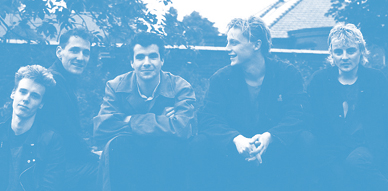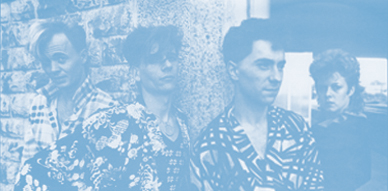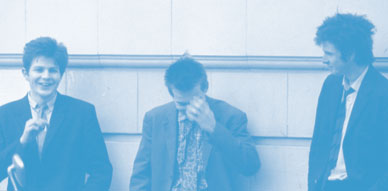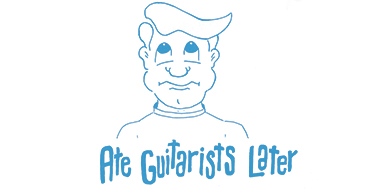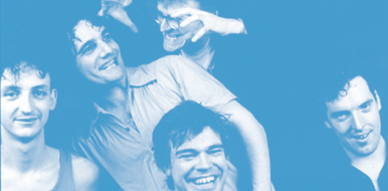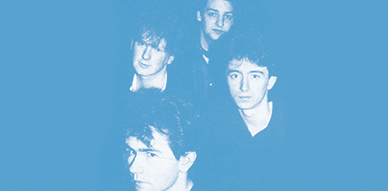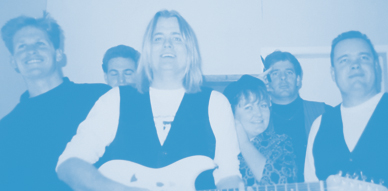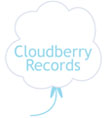Aug
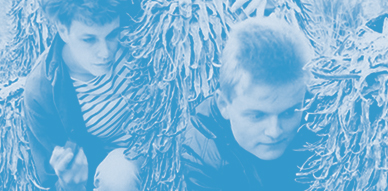
Thanks so much to Neil and Nigel Packer for the interview! I wrote about the London late 80s, early 90s, band Lobster Squad on the blog some time ago. I had discovered a trove of great recordings on Soundcloud and I was very curious about the band. They hadn’t released anything and there was very little information about them on the web. Luckily, Neil contacted me a few weeks ago and was keen on doing the interview. Best of all, both brothers answered the questions!
++ Hi Neil and Nigel! Thanks so much for being up for this interview! How are you? Are you still involved with music?
Neil: Very good thank you Roque although it feels a little strange to be talking about Lobster Squad again after all these years. I am no longer involved with the playing of music but I still listen to a great deal of it.
Nigel: I still love music, but I haven’t played the guitar regularly for years. Once or twice in recent years Neil and I have rented a rehearsal studio with friends for a jam session, but that’s about it.
++ Let’s go back in time. What are your first music memories? Do you remember what your first instrument was? How did you learn to play it? What sort of music did you listen to at home while growing up?
Neil: My earliest memories of music would be from about the age of 5 and of listening to my parents’ record collection. This would have been about 1966 / 1967 and it was probably not the most hip selection of vinyl from that period, but to the 5 year old me they were magical, James Last, The Fiddler on the Roof and The Music Man soundtracks, Herb Alpert and the Tijuana Brass, and best of all was a record by a Columbian Band “Los Corraleros de Majagual, Y Sis Estrella’s” that my father had brought back from a trip there. In addition to these there was the endless cycle of Library music from the tv test cards and children’s programmes. To this day I still adore all of these things.
By the age of 11 I was buying and listening to Glam Rock, and by the end of secondary school it would have been Prog Rock, I started art school in 1977 the year that The Sex Pistols released God save the Queen, but contrary to popular myth Punk Rock didn’t sweep aside everything that had gone before, or at least it didn’t for me. I loved it dearly but I was also exploring and listening to other music from the 60s and from the folk, classical and jazz world.
By the time I moved to London in the early 80s I was listening to and trying to make much more experimental music of my own, noodling around with old tape recorders and broken radios to try and create ever more weird sonic soundscapes but with no real understanding of musical theory. About this time Nigel and I began writing, (although I use that term very loosely) more conventional songs inspired by the fledgling indie scene in the UK and these songs would become the backbone of early Lobster Squad.
My first instrument was a guitar, I got it when I was about 6 and thinking about it now it was a pretty shoddy instrument. It had an action like a suspension bridge and even for my older slightly more accomplished self it would have been unplayable. I discovered however that you could slide a bottle up and down the fretboard, bypassing the awkward frets which made a pleasingly rich and plaintive sound that I had perhaps subconsciously heard somewhere previously. This was after all 1966 and the tail end of the British Blues Revival.
By the late 70s I had upgraded to a more playable guitar and I taught myself how to use the fret aspect of the instrument using Bert Weedon’s play in a day. We all did, didn’t we?
Nigel: I was born in 1966, so my earliest musical memories are of listening to pop songs from the very late 60s/early 70s on the radio. I also had a few children’s records – my favourite was called Sparky’s Magic Piano. I also remember a lot of great theme tunes from children’s television programmes, such as White Horses, The Magic Roundabout and Robinson Crusoe. The Banana Splits TV show was also a favourite.
My first instrument was a snare drum, followed by a toy keyboard. When I was in my mid-teens I got a second-hand drum kit which was a fantastic purple colour. I played drums in a covers band with two schoolfriends, but we never played any gigs.
I was originally more interested in playing the drums than guitar, but I eventually began playing around on an old acoustic guitar of Neil’s. I learned to play some chords from a teach yourself book – Bert Weedon’s Play In A Day (in reality it took a lot longer). I was given a copy of The Beatles’ songbook when I was about sixteen. Some of the chords were very difficult to play, but it did at least get me thinking about how songs are structured. I began to work out chord sequences to songs by other bands and started writing my own songs when I was about seventeen.
The first band I really fell in love with was Slade. This was when I was about six or seven-years-old. I used to watch them on Top of the Pops and loved their showmanship, plus Noddy Holder’s singing, of course. The next band I became a real fan of was Queen, around the time of Bohemian Rhapsody. The first album I ever bought was News of the World a couple of years later. I got into The Beatles, Stones and The Who during my teenage years, along with Jimi Hendrix, Free, Bob Marley, Pink Floyd. I also liked a lot of contemporary bands at the time, such as The Jam, The Specials and Human League.
For a while I was into heavy rock bands (Led Zep, Deep Purple, AC/DC, Rush) and prog bands like Yes and Genesis. At that time I didn’t really think about forming a band, because the musicians I was listening to were completely out of my league. That began to change when I started to get into indie music (Joy Division, New Order, Husker Du, The Jesus and Mary Chain). I realised that it was possible to make interesting music without being a virtuoso musician. It was all about putting chords together in pleasing ways. I loved the sense of melody in many indie bands, and the home-made, DIY quality of their music.
I started writing songs when I was listening to a lot of REM and The Smiths, which can be heard in Lobster Squad’s sound.
++ Had you been in other bands before Lobster Squad? What about the other band members? Are there any songs recorded?
Neil: Lobster Squad was my first and only band. There were many band members who came and went, some of whom had been in bands slightly higher up the food chain, but I don’t recall anything significant.
Nigel: In the early 80s, Neil and I used to record stuff on a tape recorder at home under the name of The Piles, but it was quite experimental and I’m not sure they could be called songs in the usual sense of the word. By the late 80s we were writing songs more seriously.
We were living in a pretty dull suburban town, and so there wasn’t much to do beyond making music. We didn’t really know any musicians at that time – especially playing indie music. Indie was more of a niche movement back then and not the dominant force it became in the Britpop era.
When we moved to London the isolation ended. There were many people around with the same taste as ourselves. Most members of Lobster Squad had been in bands previously. We were always meeting other musicians in London – it was a very fertile time for music.
We do have some other songs recorded, other than those on SoundCloud. We will try to track them down.
++ Where were you from originally?
Neil: The first stirrings of Lobster Squad happened in Essex. We were the classic example of a “bedroom band” thorough most of the mid to late 1980s. We only started playing together live as a proper band after Nigel moved to London in ‘88.
Nigel: We moved around a lot when we were children, as our dad worked for BP and was constantly being given new postings. Neil lived in the West Indies and Libya, but that was before I was born. In the early years of my life we lived in Oxfordshire, Grangemouth, Swansea, Hertfordshire and then Oxfordshire again. When I was eight we moved to Chelmsford in Essex, which is where the family settled for the next ten years or so. It was a typical suburban commuter town, about thirty miles from London. I worked for three years on the local newspaper – the Essex Chronicle – before moving up to London to work on a business magazine. Neil was already living there. It was then that we decided to finally start a band.
++ How was London at the time of Lobster Squad? Were there any bands that you liked? Were there any good record stores? Or what about the pubs or venues to go check out up and coming bands?
Neil: London was an extraordinary place to be trying to forge a musical career or indeed any other career in the arts at that time. Every second pub in London seemed to be a venue for upcoming bands, probably a legacy from the flourishing Pub Rock scene of the 70s, in addition to pubs there were multiple dedicated music venues of every size and catering to every genre. I recall seeing what I believe was Sonic Youth’s first UK gig at Thames Polytechnic, which was one of many colleges in London to host multiple gigs every week, and at one point I was probably going to 5 gigs a week. These venues are well documented elsewhere and too numerous to mention here, but I would have frequented to a greater or lesser extent well over 100 different London venues over those years.
Rather sadly though most of them no longer exist and going back over the few venues Lobster Squad actually played it appears that none of those exist anymore.
Record shops though, having gone through a similar decline to the point where there were only a handful of very specialist ones left in London are now going through something of a renaissance thanks largely to the revival of vinyl amongst the younger generations. There is still a thriving music scene in London and of course things change but I am not sure that the grass roots scene is quite as vibrant as it once was.
Nigel: It was an exciting time to be in London. There was a really strong music scene with lots of thriving mid-sized venues, such as the Powerhaus in Islington, The Mean Fiddler in Harlesden, the Town and Country Club in Kentish Town, to name just a few. This was in addition to the big venues like the Hammersmith Odeon and Wembley Arena, and (at the other end of the spectrum), local pubs which would regularly stage gigs. I went to gigs pretty regularly and saw lots of great indie bands, (The Smiths, REM, James, The La’s, The House of Love), plus music from many other genres – including Lou Reed and Van Morrison. There was a growing interest in world music at the time and lots of big names would play at venues like The Africa Centre. I always loved the melodic, joyful guitar playing of musicians like Diblo Dibala, and tried to incorporate at least some of that sound into what we were doing.
Rough Trade and Reckless Records were among the best record stores in London at the time, and there was a great world music record store called Stern’s which I often visited. Living in North London, I also went to Camden Market for second-hand records and bootlegs.
++ Were there any other good bands in your area?
Neil: My local underpass was latterly renamed Joe Strummer Subway as it was his busking pitch prior to The Clash. More local than this still, my flatmate and old art school buddy Paul was playing with a band called Bastard Kestrel who at the time were getting a fair bit of attention, (he later joined Lobster squad as our first drummer). Our next door neighbour was Rob McKahey the drummer from “Stump” who were by our standards incredibly successful having produced multiple singles, made TV appearances, videos, an album and toured with the likes of Husker Du. You couldn’t move in our small patch off the Edgware Road at that time without bumping into someone from an upcoming band or forging a career as an artist or a writer of some kind. It was a wonderful place to live before it gentrified and had its life blood sucked out of it.
Nigel: There were lots of very good bands in London, most famously around Camden. I knew plenty of people in bands, but none that were especially famous. One of our drummers, Mike Johnson, once played in a band that supported The Clash, and he even slept on Topper Headon’s couch. As for Lobster Squad, we used to practice at a rehearsal studio in Holloway, and Suede were sometimes practising next door. We listened to them through the wall but we didn’t ever meet them.
++ How was the band put together? How was the recruiting process? You were brothers? related?
Neil: Myself and my brother Nigel probably had 40 songs between us by the time we got around to actually recruiting anyone else. It was really a case of who do we know that can play this or that and shall we ask them to join. In 1989 my friend Paul became our first member, he was actually a guitarist but we needed a drummer and he quite liked the idea of being a drummer for a while. It actually worked out well and though he wasn’t particularly fancy he did keep very good time and he was reliable. That is pretty much how it was, people in the band or friends would recommend someone they knew when someone would leave.
++ Was there any lineup changes?
Neil: Oh god yes! Probably way too many. There was a pretty rapid turn around and people would leave out of frustration mainly. I can’t honestly blame them as progress was undeniably slow and the administration was utterly chaotic. In the 7 years we were actively playing as a band (by coincidence the same amount of time that the Beatles were together) we went through 13 different members.
Nigel: Lots, to the extent that each demo was effectively recorded by a different band. It was a pretty fluid line up. The only thing that remained unchanged was Neil and myself.
++ What instruments did each of you play in the band?
Neil: I played Bass and Nigel played Guitar. We started as a three piece with Nigel singing but then found a female vocalist who sang with us for a couple of years. After that we always had female vocalists as the female voice seemed to suit our songs better. However because of the multiple line up changes it felt like we were continually teaching someone the old songs or worse still having to transpose songs and re-learn them ourselves. There were some songs we learnt in 4 different keys in order to accommodate various singers.
Nigel: At first I was lead vocalist and guitarist, Neil was on bass and backing vocals and Paul was on drums and backing vocals. We then found a great singer called Sheila South (who was recommended by a friend). She sang on the second (Westbourne) and third (Camden) demos. On the Camden demo Paul switched to rhythm guitar and we had a new drummer (Mike Johnson – a friend and work colleague of mine). On the Croydon demo we had a different line-up (Eleanor on vocals and keyboards, Mike Morgan on drums and Ian Delahaye on saxophone). These new members of the band were influenced by various other genres, including jazz, funk and reggae, which is why this demo sounds quite different to the earlier ones. It was a fusion of several genres. Later still our friend Kathy sang with us, and a very old friend of ours – Steve – played keyboards. We did record a few songs together with that line-up but they are not featured on SoundCloud. We will try to find them.
++ How was the creative process for you? Where did you usually practice?
Neil: The bulk of the songs on SoundCloud were Nigel’s but I would contribute songs as occasionally did Paul. These would sometimes arrive at the rehearsals fully worked up or sometimes just as ideas with individual parts and arrangements worked out during rehearsals. We had weekly rehearsals initially in Airwave studio Kilburn (not to be confused with Air Studios in Hampstead). It was a damp basement but conveniently located under an off licence. Later we moved to the marginally better rehearsal space at Westbourne studios, and finally ended up in a rehearsal studio in Holloway. This we knew must be good because even though it was still damp with a powerful smell of urine, beer soaked carpet and spliff about it, the now very famous indie band Suede were regularly rehearsing in the slightly better appointed room next door to us.
Nigel:I would write songs on my own at home and Neil did the same. We then took the band through the songs at rehearsals. Sometimes we would suggest particular lines for each instrument, and at other times we would work on the arrangements together as a group.
++ What’s the story behind the band’s name?
Neil: It comes from (the pre cancelled) Woody Allen masterpiece, Annie Hall.
Nigel: We went through several names (Cusp, Maroon) but Lobster Squad was always the best received.
++ The first thing that caught my attention is that you didn’t get to release any records. How come?
Neil:Sadly nobody asked us to. It might have helped if we had had better contacts, or if one of us had even a vague idea of how to go about getting label interest. Looking back now it would probably have been a good idea to have found a manager as there were very few paths into the business proper at that time. None of us were natural born networkers and I for one was far more interested in producing strange backwards noises on my ancient recording devices than trying to brown nose my way into a record company.
Nigel:It was a really good era for indie music. There were many bands around, some of them excellent, and it was always a challenge to get noticed among the crowd. With hindsight we should have found a manager, as none of us were very good at plugging the band. We tended to focus entirely on the music without really thinking about how to get ourselves noticed.
++ Was there interest from labels at any point?
Neil:Absolutely none! Probably by the early 90s the indie labels which had served bands very well since the Punk era were now growing into more corporate concerns themselves or being bought up by the giants. This was pre internet of course, demos were very expensive to make and there was no guarantee anyone would listen to them. Now at least you can throw something out there yourself and hope it gets some attention.
Nigel:We sent one or two of our demos to record companies. One of them gave us some reasonably good feedback, but they didn’t think it was strong enough to sign us.
++ You did release demo tapes. From what I understand the first recordings date from 1988. Recorded at Canvey Island. Is that correct? Where thee two songs “Out of My Life” and “Pimlico” the first ones you recorded?
Neil:They were the first songs we recorded on 4 track. We had at that time about one and a half C90’s filled with recordings I had made in the bedroom with Nigel. These were very rudimentary and were bounced down multiple times between 2 or more slightly naff tape recorders but I became quite adept at recording from one tape to another without too much loss of quality. However they existed essentially as sketches to potentially be worked up later and as neither of us could really read music it was the best way of remembering them. The Canvey Island tape was a step up from that…slightly.
Nigel:It was the first time we had recorded properly on a four track machine. Before that we had recorded songs on twin cassette recorders, which allowed us to do some overdubbing. These cassettes sounded pretty muddy, though, so it was nice to get a clearer recording.
++ And what do you remember from recording at the small town of Canvey Island? Why did you end up recording there?
Neil:We were of course aware of Canvey Island’s illustrious musical pedigree with its Doctor Feelgood R&B and Pub Rock connections, but in truth the reason that we recorded there was because Nigel knew someone there who owned a 4 track recorder and a drum machine and who was willing to spend a day recording with us for no payment whatsoever. My main recollection was that it was an insanely hot day and that we were locked up in the first of what would be many small hot and stuffy rooms to come, but with enormous levels of excitement and enthusiasm at the idea of making a “Proper” recording.
Nigel:I remember it was a very hot summer’s day. We were recording in the living room of a friend, who owned the four track machine and produced the recording. He had a pet rat living inside his sofa which would pop up occasionally during the recording.
++ In 1989 you would record a 5 song demo tape at Kilburn Airwave. How was that experience? Were you more confident than the previous recordings? Did you use a producer?
Neil: We were at least a proper band who had been rehearsing together for a few months by the time we made this recording. The studio was effectively the rehearsal space which we had been using and on the day of the recording an engineer appeared, unlocked a door hitherto unnoticed and ushered us into a small space containing the mixing desk and a tape machine. The recordings were pretty much done live which worked very well as at least we knew the room. We recorded and mixed 5 songs in about 6 hours, a record that would stand until the band’s demise.
This particular demo got us our first gig at the much missed Haven Stables in Ealing (now an estate agents) ugh! They asked if we could do a 45 minute set for them the following week, to which I lied “yes that’s absolutely no problem at all” knowing that we only had 20 minutes of material rehearsed. There followed a frantic few days of working up new material and expanding some old stuff.
Nigel: We were definitely more confident at this point. It was probably the most smooth-running demo we ever made. We seemed to get everything right in one or two takes. With the other demos, it took us much longer to record something we were happy with.
++ One thing I noticed is that you have a song called “Lobster Theme”. What inspired you to create a theme song for the band?
Neil: Why would a band called Lobster Squad not want a song to play at the start of a gig called “Lobster Theme”?
Nigel: We always liked the way The Monkees had their own theme song, and so we thought that we would have one as well.
++ You continue recording demos, in 1991 at Westbourne Rehearsal Studios. I start to wonder then what was your favourite recording studio and why?
Neil:Westbourne was a good rehearsal studio and it had a very good recording facility. I think it even had a Soundcraft Desk which you wouldn’t necessarily guess from the recording. Cost wise it was probably a good deal, as we were rehearsing there every week and got to know the people who ran it, but mostly it was nearby and handy for all of us.
Nigel:Westbourne was a great place to record because we rehearsed there every week, and we knew the sound that we wanted for the recording.
++ Then are demos recorded in Camden and Croydon in the following years. You seem to have been all over the place recording. Was it because of the price? Or what made you explore so many studios?
Neil: The studio in Croydon belonged to our then sax player. It was in his basement and absolutely minute, we were a 5 piece at the time and could with some degree of tessellation just about fit in together with our instruments, but it was free and we had limitless time there which was probably its main attraction.
I think the constant searching for a decent recording studio was partly born out of frustration. Recording a Demo was a very expensive exercise and you would be allocated an engineer who had never heard your band before and who clearly wanted to be somewhere else. Their main objective was to get the recording process over with as quickly as possible, and to this end they would invariably suggest that all the instruments were directly inputted into the mixing desk stating that this would help with the separation which is of course true, but at the same time killing the very sound that you had striven for years to achieve. The sound of a room with vibrating molecules blasting from your own amplifier, precisely modulated from the settings which you had carefully and finely balanced to work in harmony with everyone else’s dynamics within the band. The results were universally dead and with not a hint of a live room or space within the finished recordings. I would say most of our recordings are victims of that.
In the very late years of the band I acquired and taught myself to use a 4 track recorder and began to record rehearsals. These were some of our better recordings but are now inaccessible as my 4 track recorder sadly died before I managed to digitise any of it.
Nigel: It was largely down to the changing personnel. The Croydon demo, for instance, was recorded at the home studio of Ian – who had joined us as saxophone player on the recommendation of one of the other band members. Price was also a factor – it was very expensive hiring a studio and an engineer for the day. I think with hindsight we should have recorded in just one or two studios, as it would have cemented our particular sound. As it was, the demos all sounded quite different to each other.
++ A song that was recorded in many versions was “Pimlico”. Was this area of London important for you in any way?
Neil:I think I was very briefly dating someone from Pimlico at the time which might be why it appears, but equally it might just be name checked because it rhymes with the word “Know”. Lyrics were never my strong point.
++ Are all of the songs on Soundcloud your recorded output? Are there more songs by the band?
Neil: There are many more but they are not in a well enough recorded or finished state to be aired, not that I am entirely sure that the songs on Soundcloud are quite polished enough either.
Nigel: We have one other studio recording, from about 1996, which features the final line-up of the band playing two new songs. I also recorded two or three other songs with our singer – Kathy – on a four-track I had bought. There are also some live recordings which hopefully one of us still has somewhere.
++ You had enough songs for an album perhaps. Wonder if you ever consider putting together some sort of retrospective album?
Neil:Yes that would be interesting. We still have all the masters from the demos we made and I would love to re mix them properly now that I understand that process better and perhaps even retrospectively apply some pro tools to them to get back to what we might have sounded like at our best.
Nigel:In total we had about forty songs (including some cover versions) which were of varying quality. Looking back, I wish we had recorded a greater variety of songs on the demos, rather than focus on different arrangements of the same five or six songs.
It would be great to put together a retrospective album, ideally using the original demo recordings. We have master tapes, so they could be remixed. Although the recordings aren’t of the greatest quality, they do capture a moment in time, and have an authentic late 80s to mid-90s sound, which I think would be difficult to replicate with current technology. These were in the days long before auto-correct, so there are a few mistakes here and there, (we are even slightly out of tune now and then), but hopefully this just adds to their character.
++ And there were no compilation appearances, right?
Neil: No none sadly.
++ My favourite song of yours is “Up to You”, wondering if you could tell me what inspired this song? What’s the story behind it?
Neil: Best that Nigel answers this question as it is one of his songs.
Nigel: It is a song about someone famous and their struggles with loneliness and depression. It’s not about any one person. When I wrote it I was thinking about various tortured film and rock stars (James Dean, Montgomery Clift, Janis Joplin). I have always liked songs which have an upbeat and cheerful melody juxtaposed with rather dark lyrics, and that was something I was trying to achieve with this song. It is one of the first songs I wrote, when I was about nineteen or twenty.
++ If you were to choose your favorite Lobster Squad song, which one would that be and why?
Neil: Probably Summer Will Soon Be Fading. It stayed in our set for the whole time we were together, it is a fairly minimal arrangement and it had an easy but very memorable bass riff which drove the song. Dancing around the same handful of notes was a catchy vocal melody and the chords shifted around the whole thing bringing it different colours. I could probably still play it now 30 years later without even thinking. it was beautifully simple but quiet beguiling. Lobster Squad, as do so many other bands, started to over complicate songs as we gradually became relatively better musicians and managed to somehow lose the joy and freedom of those early songs. I still think the early songs were among our best and “Summer” was a very early one.
Nigel: Summer Will Soon Be Fading is one of my favourites. It always seemed to be well received at gigs.
++ What about gigs? Did you play many?
Neil: Not a great many, we would play a couple of gigs as a particular line up then someone would leave and we would then need to get a new member up to speed before going through the whole getting a gig process again. We never really got to the point where we were gigging so regularly that we could actually rehearse less.
Nigel: Not a huge number, but we played at a variety of venues, such as the Powerhaus in Islington, the Bass Clef in Hoxton, the Rock Garden in Covent Garden, Haven Stables in Ealing and the White Horse pub in Putney. Sadly, most of these venues have long since closed down.
++ And what were the best gigs in general that you remember? Any anecdotes you can share?
Neil: Some of our early gigs stick with me as particular highlights. My favourite was at the much missed Rock Garden (now an Apple store) ugh! I remember having just come off stage when a guy approached me and said I think I recognise you! Pointing in the direction of the stage I proudly said yes I was in the band that just played, he replied were you? oh I didn’t notice, but I think I saw you yesterday at the Hayward Gallery which was true as I had been there, and that was the nearest brush I ever had with fame. We made £20 that night and that was the only money Lobster Squad ever made so all in all it was a very successful night for us.
Nigel: The Rock Garden was our second gig, there was a decent-sized crowd and our music went down pretty well. The last gig we played was for twenty or so friends at a rehearsal studio in Holloway. It was a really nice occasion, and we didn’t realise at the time that it would be our last performance.
++ And were there any bad ones?
Neil: Yes a terrible one at the much missed Powerhaus (now a building society) ugh! One of the band (who will remain nameless) was very, very late for the soundcheck meaning we only had about a minute to get levels worked out. We were pretty miserable at this and decided to go back to our singer’s flat for some refreshments. She lived only about a 15 min walk away. Rather stupidly we took our guitars with us on a bitter snowy February evening. We got back to the venue and went straight on stage and spent the next 30 minutes battling with our expanding metal strings as our instruments came to terms with the 40 degrees difference between a wintery Islington evening and an extremely hot stage. The resulting experiment in alternative random tuning in front of a live audience did not go down well.
Nigel: The Powerhaus gig had the biggest crowd we ever played to. There were several hundred people there, although most had come to see one of the other bands., Unfortunately the guitars slipped out of tune without us noticing. We couldn’t hear clearly what we were all playing (we didn’t get a proper soundcheck) so we didn’t sound at our best that night. It’s a shame because it was a great venue.
++ When and why did Lobster Squad stop making music? Were you involved in any other bands afterwards?
Neil: I think in truth it just run out of energy sometime in 97. Nobody actually said it’s over but at some point a rehearsal was not booked for the following week and nobody seemed to object or even notice.
Nigel: We stopped making music altogether in1997. Neil and I had been working on the band for about seven or eight years and were both now in our thirties, and we felt that it was time to move on to other things. It is quite challenging, keeping a band together through various line-up changes, and we had probably had enough by then.
++ Was there any interest from the radio? TV?
Neil: Yes once. We had a very good drummer who was a dear friend of mine and for a about a year he played with us. He eventually left the band and moved to Lodz in Poland as an English teacher. He was very quickly absorbed into the music scene there and given a radio programme of his own on radio Lodz playing mostly Reggae, which at the time was huge in Poland. On one of many trips I made to Poland he interviewed me as a fellow ex band member and played one of our songs which had a definite reggae vibe in its final incarnation. That was the only Radio airing to my knowledge that we ever got.
Nigel: The band predated the internet by some years, so it was almost impossible to get music heard by the wider public without the support of a record company or radio stations. YouTube and SoundCloud etc have completely changed the landscape and greatly increased the possibility of directly reaching an audience.
++ What about the press? Did they give you any attention?
Neil: No but I did get a photograph I took of a friend’s band published in the NME once.
++ What about fanzines?
Neil: No our genius seemed to have bypassed all of them too. I did actually consider starting one once just so we could be in it, but that is probably how most fanzines begin.
++ Looking back in retrospect, what would you say was the biggest highlight for the band?
Neil: There were many highs throughout the years particularly in the early days when rehearsals and gigs sometimes felt more like a primal scream session than work and the sheer joy of playing together when it was all going well meant that the tensions of the week would melt away. I don’t think there were any of us who wouldn’t have given up their day jobs if we had got the call from the A&R person but it wasn’t to be. But then there you are, a tiny footprint that hitherto barely existed in the history of rock and roll, so thank you Roque for giving us back a small voice.
Nigel: The best part of being in a band was rehearsing and working up songs every week. We had a lot of fun and laughs together, and there is something very liberating about being in that sort of creative environment. In terms of one particular highlight, I did enjoy the Rock Garden gig. I also loved making the demos, (I can’t really choose a favourite, they all have their strengths and weaknesses). It was great to have something tangible at the end of the day after all the hard work.
++ Aside from music, what other hobbies do you have?
Neil: Drawing and I did manage to turn that hobby into a 40 year long career as an illustrator.
Nigel: I like reading, mostly fiction, and creative writing. I had a novel published in 2015, called The Restoration of Otto Laird. I also enjoy watching sport (football, cricket) and visiting museums and galleries. I’m very interested in archaeology, but I haven’t been on an excavation for some years.
++ I’ve been to London a couple of times and really enjoyed it. But still I’d love to ask a local. What do you suggest checking out in your town, like what are the sights one shouldn’t miss? Or the traditional food or drinks that you love that I should try?
Neil: I very much have a love hate relationship with London these days, I have always lived in Paddington / Marylebone, and I currently live only about 10 mins walk from my original flat near the Joe Strummer underpass (now closed due to structural issues). Marylebone is not what it used to be and any vibrant, bohemian creative spirit it once had has long gone, driven out by abject wealth. Soho, Ladbroke Grove and Camden have fared a little better but you sometimes feel that they are still living off past glories. Having said that it is still an exciting city if you are young and my son who was born and bred in central London loves it. In the last few days alone he has seen Deerhoof play live at Kings Cross and has been to see Ligeti’s Requiem at the proms, it is still that kind of City for music.
My advice to anyone visiting is not to plan but to be a Flaneur, (the art of wandering aimlessly). London is a great city to practice this art as it will still throw up surprises and joys which are hidden in the detail of the journey rather than the obvious destinations.
Lastly support the London pubs, most of which have extraordinary histories, before they are all converted into much needed luxury housing.
Nigel: There are loads of great museums in London, but one hidden gem is Sir John Soane’s Museum in Holborn. It is full of old artefacts and antiquities (sculptures, paintings etc). It’s also a short walk from the British Museum. One of the best things about living in London is the wide array of food from all over the world. It’s worth sampling as many as possible. Also, it’s a cliché but try a real ale in a pub. Beers from East Anglia are especially good.
++ Anything else you’d like to add?
Neil: To Quote Black Francis from Pixies, “I’ve walked the sand with the Crustaceans”. Thank you to the ladies and gentlemen of Lobster Squad, it was a pleasure playing with you.
Nigel: I agree – happy days.
::::::::::::::::::::::::::::::::::::::::::::::::::::::::::::::::::::::::::::::::::::::::::::::
Listen
Lobster Squad – Up to You

